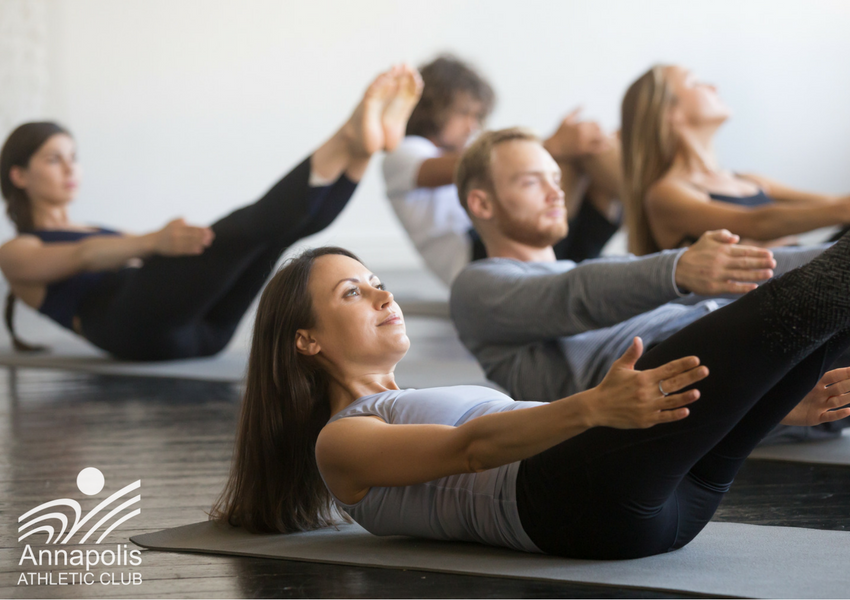Virtually every person can benefit from a regular Pilates practice, and many AAC members are already enjoying these benefits. However, we still get a lot of questions about what Pilates is, who should be doing it, and how to start. If you are curious about Pilates and how it could transform your workout routine, read this guide for some answers and inspiration to get started!
What is Pilates?
Pilates is a (deceptively) gentle exercise discipline that is known for sculpting long, lean muscle and accessing muscles deep in the core. The foundation of Pilates is total body alignment, with a particular focus on posture and the spine.
Many of the movements performed in a Pilates class will be familiar to you, but they are performed with precision and intention — this is where the real work occurs. Pilates can be just about as difficult as you make it, as your work to carefully isolate and control each movement to perfect the technique. Be prepared to be sore the next day, even the smallest of movements will work muscles you probably don’t realize exist!
Mat or Reformer Classes?
Pilates can be performed on a mat, or with a reformer. Mat classes take place in a group exercise studio and are set up in a format similar to yoga; the exercises are performed on a thin mat on the floor, with the possible addition of a few simple props, like a Power Circle. Pilates on the mat is recommended for someone who just wants to get their feet wet and is comfortable in a live class format, with 15 to 25 students working with one instructor. Keep in mind, mat classes are usually more challenging than reformer because you largely using your own body to create length and opposition, and you won’t have the support of a reformer.
Reformer classes will be performed in a studio on a piece of equipment called a reformer with a sliding carriage and attached springs and bars used to create resistance. Some instructors will also incorporate a few other larger pieces of equipment, like the tower on the Cadillac, but the majority of the class will usually take place on the reformer. If you have ever seen a Reformer machine, you may have felt intimidated by the seemingly complicated equipment — but no need to worry! Reformer classes are actually recommended for beginners who will benefit from an instructor’s focused attention as they observe your every move. At AAC, reformer classes will have a maximum of five students per class, and private and duet lessons are also available. New students are recommended to take a few private sessions to master the technique before joining a group class. AAC also offers an Introduction to Pilates Reformer class with instructor Meredith Luecker.
Who should do Pilates?
As with any new form of exercise, you should consult a doctor to find out if Pilates is right for you. Generally, Pilates is safe for people of all ages and experiences, often even those recovering from injury. Pilates is also growing in popularity to help breast cancer survivors heal from treatment by improving range of motion in the shoulders, relieving general pain, and reducing fatigue.
Pilates is excellent for aging adults, for whom regular physical activity is shown to prevent, stop, or reverse disappearing muscle mass. Stabilizing core work is a pillar of Pilates and essential for maintaining balance and preventing falls. Many chiropractors and physical therapists recommend Pilates as a supplement for treatment to build postural muscles.
Pilates is ideal cross-training for athletes. Heavy weight-bearing exercise can shorten muscles, making these muscles prone to injury. Pilates lengthens tissue and creates elasticity in important, but difficult to reach, muscles like those in the wrists and ankles.
Everyday activities like working on a computer, driving in a car, and staring down at a cellphone compromise proper spinal alignment and are responsible for many of the nagging pains that we often feel in our back, neck, and shoulders. Pilates can correct these issues and ease the pain by gently aligning the spine and strengthening the postural and core muscles.
What to wear to class?
You can wear any workout clothes that make you feel comfortable in Pilates. Fitted clothing makes it easier for the instructor to closely monitor your technique. Workout leggings, joggers, or capris are recommended, as a flared pant may get under your feet and bother you. If you prefer shorts, you may want to add a pair of spandex shorts underneath so that you feel comfortable moving and stretching. If you are slow to warm up, you may want to wear a light jacket that you can remove when your muscles are warm.
Pilates is performed without shoes, and most students will choose to practice Pilates barefoot. If you prefer socks, instructors recommend a pair with grips on the bottom for safety. Check out the Sticky Be Socks carried in the AAC retail area for a reliable pair.
Pilates is one of our favorite ways to workout, and we hope this post gave you a push to try it yourself! If you’re ready for more information and guidance, take a look at the AAC group fitness schedule and reach out to us below:

